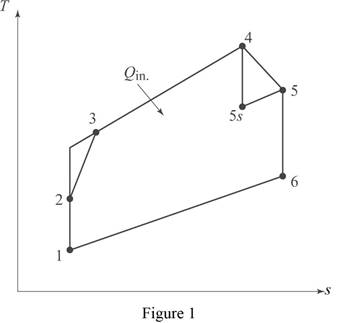
a)
The velocity of the exhaust gases
a)
Answer to Problem 137P
The velocity of the exhaust gases is
Explanation of Solution
Draw the

Consider, the pressure is
Consider that the aircraft is stationary, and the velocity of air moving towards the aircraft is
Diffuser (For process 1-2):
Write the expression for the energy balance equation for the diffuser.
Here, the energy entering the system is
Write the expression to calculate the temperature and pressure relation for the process 1-2.
Here, the specific heat ratio of air is k.
Compressor (For process 2-3)
Write the expression to calculate the pressure relation using the pressure ratio for the process 2-3.
Here, the pressure ratio is
Write the expression to calculate the temperature and pressure relation for the process 2-3s.
Write the expression for the efficiency of the compressor in the turbojet engine
Here, the specific heat of air at constant pressure is
Turbine (For process 4-5)
Write the expression for the temperature relation for the compressor and turbine.
Write the expression for the efficiency of the turbine in the turbojet engine
Write the expression to calculate the temperature and pressure relation for the process 4-5.
Nozzle (For process 5-6)
Write the expression to calculate the temperature and pressure relation for the isentropic process 4-5.
Write the expression for the energy balance equation for the nozzle.
Conclusion:
From Table A-2a, “Ideal-gas specific heats of various common gases”, obtain the following values of air at room temperature.
The rate of change in the energy of the system
Substitute
Here, the specific heat at constant pressure of air is
Substitute 0 for
Equation (XI).
Substitute 32 kPa for
Substitute 12 for
Substitute 280.0 K for
Substitute 0.80 for
Substitute 1100 K for
Substitute 0.85 for
Substitute 674.2 K for
Substitute 738.1 K for
The rate of change in the energy of the system
Substitute
Substitute 738.1 K for
Hence, the velocity of the exhaust gases is
b)
The propulsive power produced by the turbojet engine
b)
Answer to Problem 137P
The propulsive power produced by the turbojet engine is
Explanation of Solution
Write the expression to calculate the propulsive power produced by the turbojet engine
Here, the mass flow rate of air through the engine is
Conclusion:
Substitute
Hence, the propulsive power produced by the turbojet engine is
c)
The rate of fuel consumption.
c)
Answer to Problem 137P
The rate of fuel consumption is
Explanation of Solution
Write the expression to calculate the heating value of the fuel for the turbojet engine
Write the expression to calculate the mass flow rate of fuel for the turbojet engine
Here, the calorific value of the fuel is HV.
Conclusion:
Substitute
Substitute
Hence, the rate of fuel consumption is
Want to see more full solutions like this?
Chapter 9 Solutions
THERMODYNAMICS LLF W/ CONNECT ACCESS
- Uppgift 2 (9p) I77777 20 kN 10 kN/m 4 [m] 2 2 Bestäm tvärkrafts- och momentdiagram för balken i figuren ovan. Extrempunkter ska anges med både läge och värde i diagrammen.arrow_forward**Problem 8-45.** The man has a mass of 60 kg and the crate has a mass of 100 kg. If the coefficient of static friction between his shoes and the ground is \( \mu_s = 0.4 \) and between the crate and the ground is \( \mu_c = 0.3 \), determine if the man is able to move the crate using the rope-and-pulley system shown. **Diagram Explanation:** The diagram illustrates a scenario where a man is attempting to pull a crate using a rope-and-pulley system. The setup is as follows: - **Crate (C):** Positioned on the ground with a rope attached. - **Rope:** Connects the crate to a pulley system and extends to the man. - **Pulley on Tree:** The rope runs over a pulley mounted on a tree which redirects the rope. - **Angles:** - The rope between the crate and tree forms a \(30^\circ\) angle with the horizontal. - The rope between the tree and the man makes a \(45^\circ\) angle with the horizontal. - **Man (A):** Pulling on the rope with the intention of moving the crate. This arrangement tests the…arrow_forwardplease solve this problems follow what the question are asking to do please show me step by steparrow_forward
- please help me to solve this problem and determine the stress for each point i like to be explained step by step with the correct answerarrow_forwardplease solve this problem for me the best way that you can explained to solve please show me the step how to solvearrow_forwardplese solbe this problem and give the correct answer solve step by step find the forces and line actionarrow_forward
- please help me to solve this problems first write the line of action and them find the forces {fx=0: fy=0: mz=0: and them draw the shear and bending moment diagram. please explain step by steparrow_forwardplease solve this problem step by step like human and give correct answer step by steparrow_forwardPROBLEM 11: Determine the force, P, that must be exerted on the handles of the bolt cutter. (A) 7.5 N (B) 30.0 N (C) 52.5 N (D) 300 N (E) 325 N .B X 3 cm E 40 cm cm F = 1000 N 10 cm 3 cm boltarrow_forward
 Elements Of ElectromagneticsMechanical EngineeringISBN:9780190698614Author:Sadiku, Matthew N. O.Publisher:Oxford University Press
Elements Of ElectromagneticsMechanical EngineeringISBN:9780190698614Author:Sadiku, Matthew N. O.Publisher:Oxford University Press Mechanics of Materials (10th Edition)Mechanical EngineeringISBN:9780134319650Author:Russell C. HibbelerPublisher:PEARSON
Mechanics of Materials (10th Edition)Mechanical EngineeringISBN:9780134319650Author:Russell C. HibbelerPublisher:PEARSON Thermodynamics: An Engineering ApproachMechanical EngineeringISBN:9781259822674Author:Yunus A. Cengel Dr., Michael A. BolesPublisher:McGraw-Hill Education
Thermodynamics: An Engineering ApproachMechanical EngineeringISBN:9781259822674Author:Yunus A. Cengel Dr., Michael A. BolesPublisher:McGraw-Hill Education Control Systems EngineeringMechanical EngineeringISBN:9781118170519Author:Norman S. NisePublisher:WILEY
Control Systems EngineeringMechanical EngineeringISBN:9781118170519Author:Norman S. NisePublisher:WILEY Mechanics of Materials (MindTap Course List)Mechanical EngineeringISBN:9781337093347Author:Barry J. Goodno, James M. GerePublisher:Cengage Learning
Mechanics of Materials (MindTap Course List)Mechanical EngineeringISBN:9781337093347Author:Barry J. Goodno, James M. GerePublisher:Cengage Learning Engineering Mechanics: StaticsMechanical EngineeringISBN:9781118807330Author:James L. Meriam, L. G. Kraige, J. N. BoltonPublisher:WILEY
Engineering Mechanics: StaticsMechanical EngineeringISBN:9781118807330Author:James L. Meriam, L. G. Kraige, J. N. BoltonPublisher:WILEY





